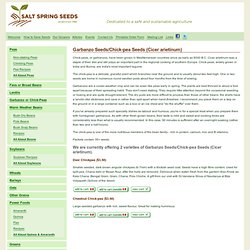

Gardening - Q&A Rotating Crops - ArcaMax Publishing. Greenlee Nursery. Ever Bearing Tribute Strawberries. Garbanzos or Chick-peas (Cicer arietinum) Seeds (Heirloom, Heritage and Organic) Chick-peas, or garbanzos, have been grown in Mediterranean countries since as early as 8000 B.C.

Cicer arietinum was a staple of their diet and still plays an important part in the regional cooking of southern Europe. Chick-peas, widely grown in India and Burma, are India's most important legume. The chick-pea is a delicate, graceful plant which branches near the ground and is usually about two feet high. One or two seeds are borne in numerous round swollen pods about four months from the time of sowing. Garbanzos are a cooler-weather crop and can be sown like peas early in spring. If you've already prepared such specialty dishes as tabouli and humous, you're in for a special treat when you prepare them with homegrown garbanzos.
The chick-pea is one of the more nutritious members of the bean family - rich in protein, calcium, iron and B vitamins. Packets contain 35+ seeds. Desi Chickpea ($3.50) Smaller seeded, dark brown angular chickpea (6-7mm) with a thickish seed coat. Heritage Red Raspberry Rubus x 'Heritage' Spring Hill Nursery. Everbearing Strawberry - Buy 25, Get 25 Free - Henry Field's Seed & Nursery.
Best and Worst Companion Plants for Tomatoes. There are plants that work well together and plants that should be kept apart.

Matching the two groups into a garden plan is often difficult, especially in a small space. Companion planting tomatoes is a lot easier than trying to lay out your entire vegetable garden with good companions. Companion planting is part experience, part folklore, and part wishful thinking. Most companion planting teachings are passed down by gardeners who experimented with pairing plants and had some success. However there are a lot of things that can impact the effectiveness of plant companions, so do not expect magic. Luckily tomatoes make good companions with the majority of popular garden vegetables. 507-0319-Compost-Guide. Seascape Strawberry Plant. How to Make Hot Compost. Hot compost is a quick and easy way to get through your waste.

A hot compost pile can reach temperatures of 49-77 degrees Celsius (120-170 degrees Fahrenheit) in just a few days, and if you get it right, you can compost your organic matter in around four weeks. You can even use these high temperatures to heat your water, home or greenhouse. The temperature of the pile must be monitored because remaining at a temperature of 65 degrees Celsius or higher for even just a few hours, will kill beneficial microorganisms that add to your compost. What you will need Equal parts green and brown materials, all shredded to a small size. Natural Rooting Stimulants for Gardening. Welcome to Freeplants.com! A Simple Way To Root Plants From Cuttings. How to Make Homemade Potassium for Plants.
How to Make Fast Compost, how to make compost in 14 days. Not everyone feels compelled to make compost in 14 days.

It just seems like too much work for some of us. However, many people are certainly interested in making the compost process faster. By learning about the key factors in making fast compost we can begin making our own compost piles more efficient, regardless of whether our compost is finished in 2 weeks or in 2 months. A popular method of composting, known as the Indore Method, involves piling carbon rich and nitrogen rich materials in alternating layers and letting them stand for a year, after which they are ready to use. Many composters use a modified version of this method, by turning their pile every few weeks or months in order to speed up the process. A faster method of composting was introduced by Robert D Raabe, a professor of plant pathology at the University of California, Berkeley.
Best Drought Tolerant Flowers and Plants. 1.

Agave Agaves store water in their thick foliage and send their roots deep below the soil surface to collect the water available. The Leaf has sharp edges. Landscapers often use agaves due to the unusual shape of their foliage, and of course, they are low care and drought tolerant plants. 2. Bougainvillea is a champion in tolerating the drought. Also Read: Heat Tolerant Flowers 3. Moss rose, or “Portulaca” is a drought-tolerant flowering plant that thrives in dry, poor soil. 4. Lithops are unique stone like succulent plants due to the reason they are also known as “Living stones.” Stevia Plant – How to Grow It and How to Use It for Extract and More. Vegetable Garden Planner Growing Guide. When to plant vegetables - When2Plant.com.
Soil Nutrient Deficiencies and How to Fix Them. Baker Creek Heirloom Seed Co. Three Sisters Companion Planting Method. Companion planting is a useful gardening technique of growing certain veggies together to take advantage of their natural tendencies and relationships.

This is an idea that has been practiced for centuries, and most famously with the “Three Sisters” method. Watch our video where Tricia shows how easy it is to plant using the Three Sisters method. Companion Plants in the Three Sisters Method The three sisters is a combination of these three plants working together: “Sister Beans”–deposit nitrogen from the air into the soil, in a form that the plants can use.Plant pole beans such as Blue Lake, Scarlet Runner, or Italian Snap, NOT bush beans.Make sure to inoculate your seeds with nitrogen-fixing Rhizobium bacteria, such as the Garden Combination Mix.The beans will use the corn as support, so wait to plant the beans until the corn is about knee high. Garden Layout for the Three Sisters Planting. What Kinds of Beans to Use for a Three Sisters Garden. Welcome to the Master Gardeners of Orange County Website - UCCE Master Gardeners of Orange County, CA.
Seed Savers Exchange Heirloom Seeds. Gurney's Seed and Nursery - America's Most Complete Seed and Nursery Company Since 1866. VeggiePlantingGuide.